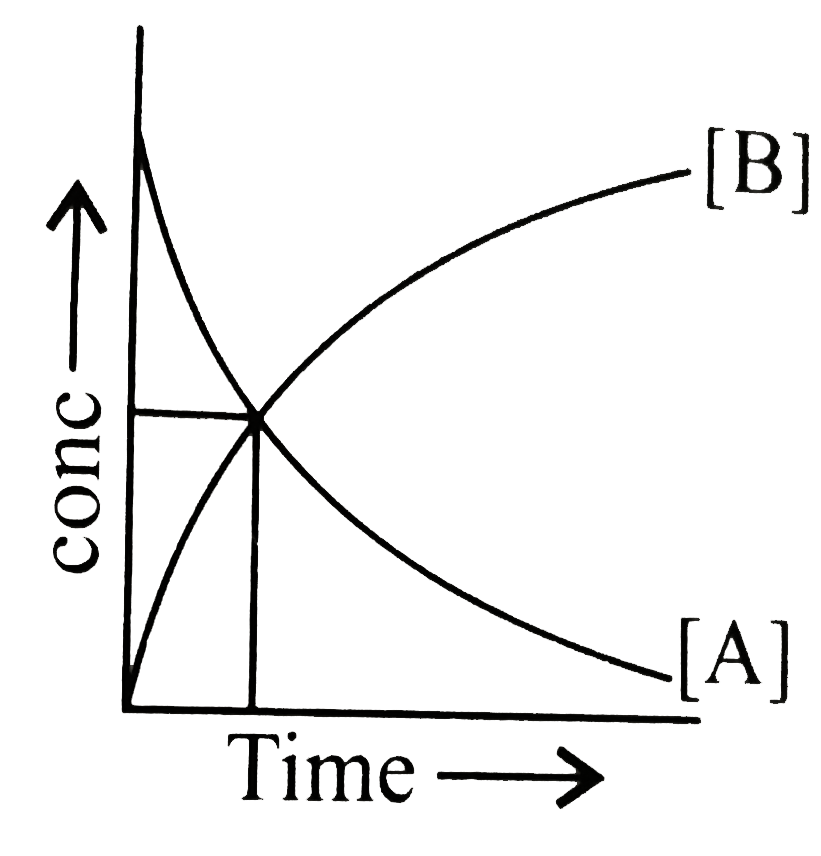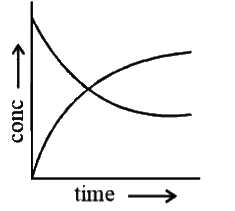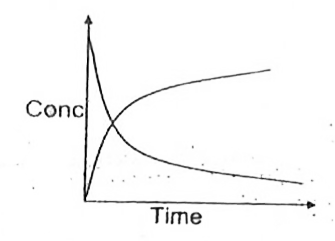The accompanying figure depicts a change in concentration of species A and B for the reaction A→B, as a function of time. The point of inter section of the two curves represents

t1/2
t3/4
t2/3
Data insufficient to predict
The correct Answer is:A
The intersection point indicates that half life to the reactant A is converted to B.
Topper's Solved these Questions
- BOOK - CENGAGE CHEMISTRYCHAPTER - CHEMICAL KINETICSEXERCISE - Exercises Assertion-Reasoning22videos
CHEMICAL KINETICS
- BOOK - CENGAGE CHEMISTRYCHAPTER - CHEMICAL KINETICSEXERCISE - Exercises Integer15videos
CHEMICAL KINETICS
- BOOK - CENGAGE CHEMISTRYCHAPTER - CHEMICAL KINETICSEXERCISE - Exercises Multiple Correct34videos
CHEMICAL KINETICS
- BOOK - CENGAGE CHEMISTRYCHAPTER - CARBOXYLIC ACIDS AND THEIR DERIVATIVESEXERCISE - Exercises Archives (Analytical And Descriptive)34videos
CARBOXYLIC ACIDS AND THEIR DERIVATIVES
- BOOK - CENGAGE CHEMISTRYCHAPTER - COORDINATION COMPOUNDSEXERCISE - Archives Subjective18videos
COORDINATION COMPOUNDS
Similar Questions
An irreversible reaction A+B→P is studied under conditions where initial concentrations of A and B are equal.Under these circumstances a graph of In A as a function of time is linear.What is the order of the reaction with respect to A with given data?
View SolutionAt the point of intersection of the two curves shown for the reaction

A→nB time →
then concentration of B is given by :View Solution
Knowledge Check
- Question 1 - Select One
The accompanying figure depicts a change in concentration of species A and B for the reaction A→B, as a function of time. The point of inter section of the two curves represents
 At1/2Bt3/4Ct2/3DData insufficient to predict
At1/2Bt3/4Ct2/3DData insufficient to predict - Question 2 - Select One
The accompanying figure depicts a change in concentration of species A and B for the reaction A→B, as a function of time. The point of inter section of the two curves represents
 At1/2Bt3/4Ct2/3DData insufficient to predict
At1/2Bt3/4Ct2/3DData insufficient to predict - Question 3 - Select One
The figure shows the change in concentration of species A and B as a function of time.
The equilibrium constant Kcfor the reactionA(g)⇔2B(g) is :
 AKc>1BK<1CK=1Ddata insufficient
AKc>1BK<1CK=1Ddata insufficient
The slope of the tangent at a point on the curve of concentration of a reactant as a function of time gives the instantaneous rate of reaction.
View SolutionThe magnetic field at all points within the cyllindrical region whose cross section is indicated in the accompanying Figure starts increasing at a constant rate α. T/s. find the magnitud of electric field as a function of r, the distance from the geometric centre of the region.
 View Solution
View SolutionAt the given point of intersection of the two curves shown concentration of B is given by ………for, A=3B
 View Solution
View SolutionConsider a reaction 2A+B→ Products. When the concentration of B alone was doubled, the half life did not change. When concentration of A alone was doubled, the rate increased by two times. The unit of rate constant for the reaction is:
View SolutionConsider a reaction, 2A+B→ Products
When concentration of B alone was doubled, the half-life did not change. When the concentration of A alone was doubled, the rate incresed by two times. The unit of rate constant for this reaction is :View Solution

